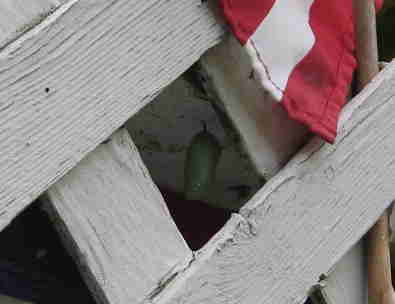![]() Observation: The First Step in the Scientific Method
Observation: The First Step in the Scientific Method
To observe means to look at something and to notice the details. When people observe things they often wonder why it is that way. Scientists try to answer that question. They make observations as the first step to the scientific method.
Observations are also called data. There are two kinds of data.
- Qualitative data which are descriptions that do not have numbers.
The campers barely noticed the chilly night air, as they spent the late night hours watching the shower of falling stars in breathless wonder, is an example of qualitative data.
- Quantitative data are obtained by making measurements and have numbers.
Scientists use instruments (tools) to obtain numbers based data.The Leonid ZHR on Nov. 18 9:30-13:30 UT was measured at 23 +/- 4. is an example of quantitative data.
It is important to be a careful observer. The details can be critical to finding the answer to a question.
I photographed this cozy thing in September 2008.
How many details you can gather?
1. Write your observations - one per line - on a piece of paper.
Make as many observations as you can.
2. Imagine - If you were standing in the scene:
What tools (instruments) would help you to be a better observer?
What measurements would you make?
3. Write at least two questions that you have about what you have observed.
"In some circumstances, scientists can control conditions deliberately and precisely to obtain their evidence. They may, for example, control the temperature, change the concentration of chemicals, or choose which organisms mate with which others. By varying just one condition at a time, they can hope to identify its exclusive effects on what happens, uncomplicated by changes in other conditions. Often, however, control of conditions may be impractical (as in studying stars), or unethical (as in studying people), or likely to distort the natural phenomena (as in studying wild animals in captivity). In such cases, observations have to be made over a sufficiently wide range of naturally occurring conditions to infer what the influence of various factors might be. Because of this reliance on evidence, great value is placed on the development of better instruments and techniques of observation, and the findings of any one investigator or group are usually checked by others."1
4. You are going to observe this object to see what happens.
Describe a method to continue to observe this object.
“In the beginner's mind there are many possibilities; in the expert's mind there are few." Shunryu Suzuki
Explore further:
Participate - Monarch Larval Monitoring Project | Milkweed and Monarch Butterfly Mania
About Units of Measurement - IB Biology | Observing Biology how to's
Temperature facts and figures - IB Biology
Steps of the Scientific Method - Science Buddies | Learn about the Scientific Method Activity
Observation - Science Skills Builders
1. American Association for the Advancement of Science. (1989). Science for all Americans: A Project 2061 report on literacy goals in science, mathematics, and technology. Washington, DC: Author. [Available online at: http://www.project2061.org/tools/sfaaol/sfaatoc.htm
Bluebirds Project | Fields, Meadows and Fencerows EcoStudy Unit | Wetlands EcoStudy Unit | Water and Watersheds unit
![]()
All trademarks, copyright and logos belong to their respective owners.
Internet Hunts / Nature / Computers / Pennsylvania Projects / Milkweed and Monarch Butterfly Mania / Puzzles & Projects / Site map / Home
Cynthia J. O'Hora Posted 3/2009 released to free use in a nonprofit setting.
Aligned
with Pennsylvania Academic Standards | Rubric
Template at Bernie Dodge site
![]() Save a tree - use a Digital Answer Format - Highlight the text. Copy it. Paste it in a word processing document. Save the document in your folder. Answer on the word processing document in an easily read, contrasting color or font. (Not yellow ) Avoid fancy fonts like: Symbols, Techno,
Save a tree - use a Digital Answer Format - Highlight the text. Copy it. Paste it in a word processing document. Save the document in your folder. Answer on the word processing document in an easily read, contrasting color or font. (Not yellow ) Avoid fancy fonts like: Symbols, Techno, ![]() fonts). Save frequently as you work. I have never liked losing my work. You will not like it either. Be sure to enter your name & the date at the top of the document. Submit via email attachment or class dropbox. Bad things happen: Save a copy of the response document for your records.
fonts). Save frequently as you work. I have never liked losing my work. You will not like it either. Be sure to enter your name & the date at the top of the document. Submit via email attachment or class dropbox. Bad things happen: Save a copy of the response document for your records.
Proof your responses. It is funny how speling errors and typeos sneak in to the bets work. ![]() Make your own printer paper answer sheet
Make your own printer paper answer sheet
Pennsylvania Academic Standards - The Nature of Science
Processes, Procedures and Tools of Scientific Investigations
• Apply knowledge of scientific investigation or technological design in different contexts to make inferences to solve problems.
• Use evidence, observations, or a variety of scales (e.g., time, mass, distance, volume, temperature) to describe relationships.
